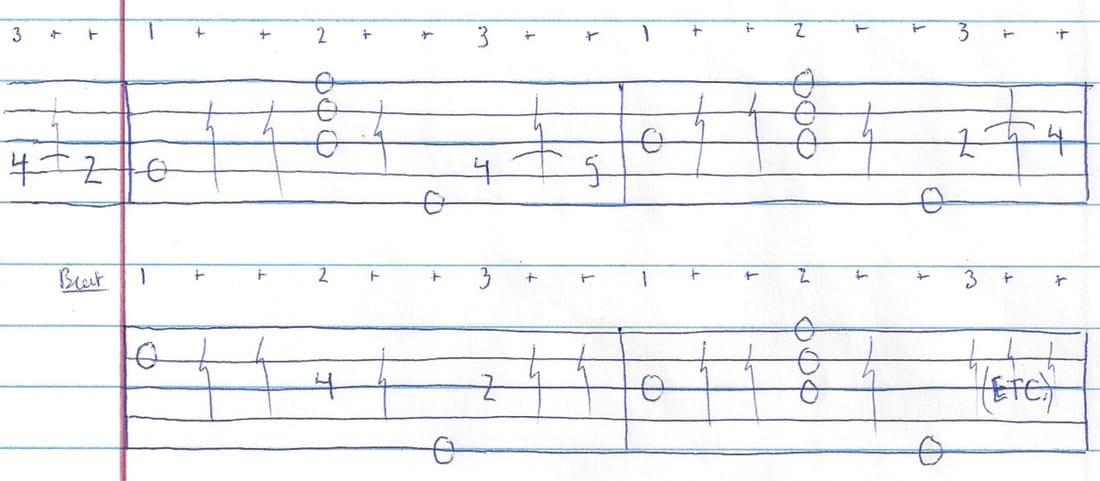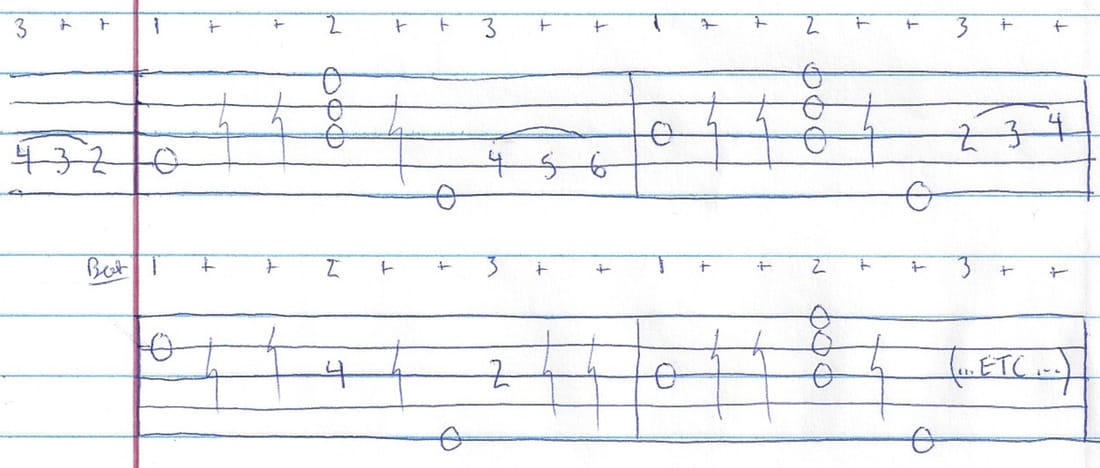|
A couple weeks back I wrote a blogpost about playing waltzes on clawhammer banjo (here), something that I've noticed a lot of players shy away from at jams. I've got a bit more to say on that subject, so coming at you from New Hampshire (where I reside with my in-laws during the holidays), I bring you "Clawhammer waltzes, part 2." The main purpose of this post is to discuss the "swing rhythm" types of waltzes frequently encountered in Old Time Music - its my opinion that these waltzes, rather than their tamer non-swinging counterparts are the ones that truly tongue-tie most clawhammer players. So lets dive in!
As I said in my last post on waltzes (once again, here) I use the term "Waltz" to describe any tune in triple time (i.e. time signatures like 3/4 or 9/8 where beats are corralled into groups of three). In that post I used "the First Noel" as an example of a seasonally-appropriate waltz that would hopefully be familiar to most people reading. Though Christmas has passed, humor me by listening to that example one more time:
Example 1 - "The First Noel" played with straight rhythm on clawhammer banjo. Note that a tab of this tune is available in my last waltz post (here).
Now listen to a second version of that tune, with a little more "swing" in it and see if you can spot the difference:
Example 2 - "The First Noel" played with swing rhythm on clawhammer banjo.
Hear that loping rhythm? Thats what I call "swing rhythm," which is in contrast to the "straight rhythm" you can hear in Example 1. So whats going on here? To get an answer let's first check out a bit of the tab I included last week:
Figure 1 - The opening line of "the First Noel" played on clawhammer banjo. The above tab is meant to be played in double D tuning (aDADE).
You could refer to the tab shown in Figure 1 to play either version of the tune (i.e. Example 1 or 2), and indeed sheet music for many waltzes shows them written in straight rhythm, though they may be played with swing rhythm in practice. To extract swing rhythm out of the tab above, just keep the on-beat notes (those with numbers above them in the tab) where they are, but move the "and-beat" notes (those with "+"s above them) back in time a bit. In other words, while the beat is normally counted as follows: "1 and 2 and 3 and," you could get swing rhythm in the tune by counting this way: "1....and 2....and 3....and," with the ellipses indicating slight pauses. Most players can fall right into this rhythm with just a bit of practice - for fun, try swinging the one of the basic waltz rhythms I introduced in my last waltz post (again, here):
Figure 2 - The "Bum-ditty-ditty" rhythm I introduced as a basic waltz rhythm. This example is written in "straight rhythm" but can be played in "swing rhythm" by simply delaying the thumb pulls a bit.
But, this approach is a wishy-washy: how would one explicityl indicate swing rhythm in tab? To figure this out, we need to figure out how long the "pauses" in the "one.....and two....and three....and" rhythm we discussed above are. It turns out these pauses are actually just long enough to fit an extra note into. To illustrate what I'm talking about listen to this (admittedly silly) example of "the First Noel" where I've inserted an extra chromatic note into a couple of phrases to fill some space in the tune:
Example 3 - The opening phrase of "the First Noel" with a couple of chromatic notes added in.
If you were to cut the middle note out of the triplet slurs in Example 3, you'd end up with the same type of rhythm you heard in Example 2. It turns out that the best way to write out a swing rhythm waltz in tab form is to subdivide the beats into groups of three rather than groups of two; I've chosen to indicate this in tab by putting two "+" marks after each beat. Here's a swing rhythm version of Figure 1 (which corresponds to what I play in Example 2):
Figure 3 - A swing rhythm version of the opening phrase from "the First Noel" (a swing rhythm version of Figure 1 and an explicit rendering of what's played in Example 2).
And for good measure, here's the "bum-ditty-ditty" rhythm from Figure 2 written in swing rhythm:
Figure 4 - A swing rhythm version of the "bum-ditty-ditty" rhythm shown in Figure 2.
(maybe call it a bum-diiiiiiity-diiiiiity rhythm? : )
So, rather than counting swing rhythm waltzes as "One....and two....and three...and" we can count them as follows: "one and and, two and and, three and and." It's just that the first "and" after the beat is typically left empty while notes may be played on the second "and." To inject a bit of music theory, these types of tunes could be written in a time signature like 9/8, also a triple meter, in order to accomodate "splitting the beats into three" as I've discussed above....but I find the "1 + + 2 + + 3 + +" approach works well for tab.
So, what are the right hand concerns when playing swing rhythm waltzes? To answer that question, let's go back to the rules governing right hand stride (first introduced here) and try to figure out how these swing rhythm waltzes fit in: ---------------------------- Rules governing right hand stride: Rule 1 for maintaining right hand stride: The index finger of the right hand moves towards the strings on every beat; the thumb never plays notes on the beat. Rule 2 for maintaining right hand stride: The index finger is never used to play notes between beats; these notes should be played with the thumb of the right hand, with a left hand pluck, or by hammer-ons/pull-offs from notes played on preceding beats. Rule 2a) if the note on an "and" beat is on a lower string than the preceding note (or if the preceding beat contains a brush, cluck, or ghost note) this note should be played with the thumb of the right hand, or by plucking the string with the left hand. Rule 2b) if the note on an "and" beat is at a higher fret of the same string of the preceding note, this note should be played with a hammer on. Rule 2c) if the note on an "and" beat is at a lower fret of the same string of the preceding note, this note should be played with a pull off. Rule 2d) if the note on an "and" beat is on a higher string than the preceding note, this note should be played by plucking the string with the left hand. --------------------------- In my last post on waltzes (final time, I promise: here) I mentioned that all of these rules governing right hand stride could easily be applied to walzes as well....however, I was focusing on "straight rhythm" waltzes in that post. Do the rules governing right hand stride hold up to swing rhythm waltz playing? Well, if you're only playing on one of the "and" beats after each beat, as would be the case for the "swing rhythm" playing we've been talking about here, no editing needed - these rules work just fine. However, sometimes swing rhythm waltzes require you to play notes on both "and" beats following a numbered beat. This can present some problems for clawhammer players. Using the same finger/thumb twice in a row would break right hand stride, so we'll avoid discussing those possibilities for now. If you have to play notes on two consecutive "and" beats, there are a couple of ways to do this without breaking stride. First, if all the notes are available on the same string, you can figure out a series of hammer-on's and pull-off's to allow you to play them from a single pluck with the striking finger. This is the approach I took to add the chromatic runs into "the First Noel" in Example 3:
Figure 5 - Adding chromatic runs into "the First Noel" using strings of hammer-ons and pull-offs.
This is the approach I used to play Example 3.
If the notes you want are on different strings and can't be reached by hammer-ons or pull-offs, you can get one of them with a left hand pluck. As an example, we could put some left hand plucks in to add to the "bum-ditty-ditty" rhythm, outlined in Figure 4.
FIgure 6 - Using left hand plucks to get (I guess) a "bum-ditt-a-ty-ditt-a-ty" rhythm. Note that I decided to call them "left hand pulls" in the above example...not sure where that came from but pull=pluck.
Now that I've (hopefully) whetted your apetite for swing rhythm waltzes, I think I'll end this post here for now. As an exercise, I'd suggest running through the tab of "the FIrst Noel" (here) with both straight rhythm (as played in Example 1) and swing rhythm (as played in Example 2) to get used to the differences in feel. Next week I'll talk about rule-breaking in a waltz context and give tab and audio for "Swannanoah Waltz," a swing rhythm waltz in D, which I recently played at a local squaredance (here).
---------------------- Finally, this week (which once again, I've spent in New Hampshire) a friend I met at Clifftop took me to a Boston-area jam at Doyle's pub, where I got to play with some really fantastic musicians! Later in the week, another Clifftop buddy also hosted a fantastic jam at her house - I'm lucky to have camped next to such a friendly group on my first Clifftop excursion! To anyone reading this: Happy New Year : )
1 Comment
2/6/2018 04:07:02 am
It was an awesome track to listen when you are having something to know for the first time. You are showing the most fascinating music which has been my favorite all the time.
Reply
Leave a Reply. |
-----
|






 RSS Feed
RSS Feed